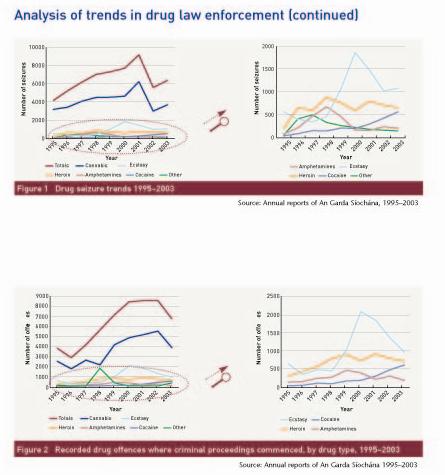Connolly, Johnny (2005) Analysis of trends in drug law enforcement. Drugnet Ireland, Issue 13, Spring 2005, pp. 14-16.
| Preview | Title | Contact |
|---|---|---|
|
PDF (Drugnet Ireland, issue 13)
- Published Version
407kB |
The Garda Síochána Annual Report 2003 was published in late 2004.1 The report includes a specific chapter on drug offences (Misuse of Drugs Act 1977) (MDA). This details information such as the number of drug offences in which proceedings were taken by police division and drug type, particulars of drugs seized, the number, age and gender of persons charged, and the nature of the offence 1.
Although the numbers of drug seizures in any given period can be affected by such factors as law enforcement resources, law enforcement strategies and priorities, and by the vulnerability of traffickers to law enforcement activities, seizure numbers are considered as indirect indicators of the supply and availability of drugs. As the quantities of drugs seized can vary significantly from year to year, with a few very large seizures in one year distorting the overall picture, the number of separate seizures is generally regarded as a more useful indicator. Figure 1 shows drug seizure trends between 1995 and 2003.
Following a 39 per cent drop in the total number of drug seizures between 2001 and 2002,2 total seizures in 2003 increased from 5,603 to 6,377. This increase came about largely as a result of a slight increase in cannabis and ecstasy seizures and a 32 per cent increase in cocaine seizures. Cannabis seizures normally make up the bulk of all drug seizures. However, when we focus on drugs other than cannabis (Figure 1 inset), we can see, for example, the steady growth in cocaine seizures, with most other drugs remaining relatively stable or declining. Ecstasy seizures rose slightly in 2003, following a sharp decline since 2000.
Drug seizure trends 1995–2003 
A key performance indicator in the national drugs strategy 2001–2008 is to increase the volume of opiates and all other drugs seized by 25 per cent by the end of 2004 and by 50 per cent by the end of 2008, using seizures in 2000 as a base. It is apparent from media reports and parliamentary debates on this subject that volume here is being calculated in terms of the street value of the total quantity of drugs seized in a given year. When volume is assessed in this way, the total value of seizures has increased from €31 million in 2000 to €121 million in 2003.3
However, if we use the more reliable indicator of the number of separate seizures as an indicator of performance, we can see that the total number of drug seizures has declined by 17 per cent since 2000 (Table 1). Although the overall trend is downward, the number of heroin seizures has increased by 10 per cent and the number of cocaine seizures has increased by 175 per cent over the same time period.
Figure 2 shows trends in prosecutions by drug type between 1995 and 2003. Cannabis-related prosecutions made up 58 per cent of the total in 2003, a reduction on the 2002 figure of 65 per cent. However, cocaine-related prosecutions accounted for 9 per cent of the total number of prosecutions in 2003, up from 6 per cent in 2002. Cannabis, heroin, ecstasy and amphetamine-related prosecutions all declined during 2003.
The total number of drug offences where criminal proceedings commenced decreased by just over 10 per cent in 2003.4 However, a larger proportion of these (25%) were for drug dealing (Section 15, MDA) than in the previous year (19%). In 2003, 67 per cent of the offences where criminal proceedings commenced were for simple possession (Section 3, MDA). In 2002, 76 per cent of offences were for possession.
The annual reports of An Garda Síochána are the main source of information about crime in Ireland. However, a number of concerns have been raised in relation to their reliability. The Expert Group on Crime Statistics, established to consider such issues, submitted a number of recommendations to the Minister for Justice, Equality and Law Reform in July 2004.5 A minority report of the Expert Group concluded that a lack of clarity regarding the collation of information relating to crimes reported to and recorded by An Garda Síochána meant that the Group was unable to reach conclusions ‘about the quality, reliability and accuracy of Garda data’.6
1. An Garda Síochána (2003) Annual report 2003. Dublin: Stationery Office.
2. See Drugnet Ireland, Issue 10, March 2004.
3. Michael Mc Dowell TD, Minister for Justice, Equality and Law Reform, Dáil Debates, written answer, 8 December 2004 Vol. 594 No.4.
4. An Garda Síochána (2003) p. 79.
5. Expert Group on Crime Statistics (2004) Report. Dublin: Department of Justice, Equality and Law Reform.
6. Expert Group on Crime Statistics (2004a) Minority Report. Dublin: Department of Justice, Equality and Law Reform.
Repository Staff Only: item control page